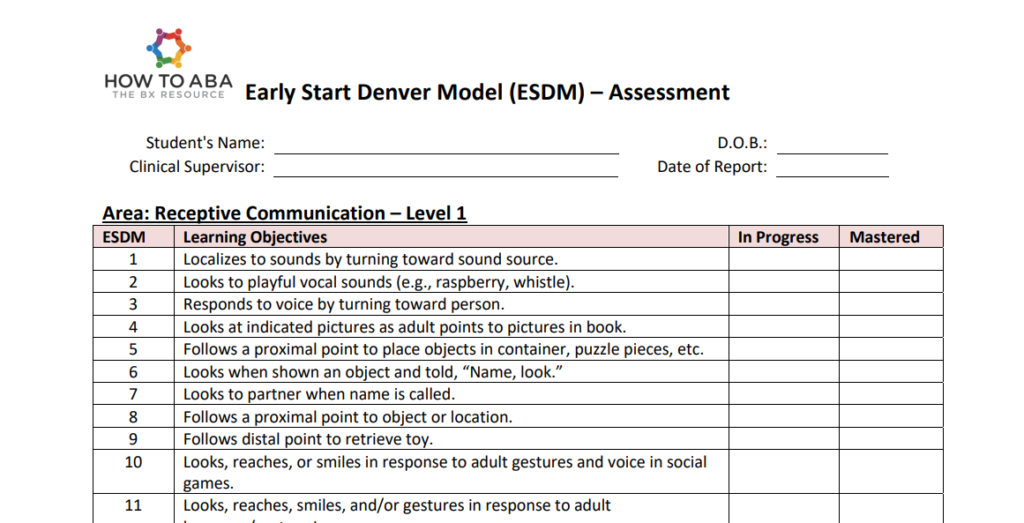The Early Start Denver Model (ESDM) is an evidence-based, comprehensive early intervention program for young children with autism spectrum disorder (ASD). The program is designed to promote social communication and language development, as well as positive behavior and cognitive skills. ESDM is based on the principles of applied behavior analysis (ABA) and developmental psychology.

Early Start Denver Model Checklist PDF Free Download
The Early Start Denver Model (ESDM) is an evidence-based, comprehensive early intervention program for young children with autism spectrum disorder (ASD). The program is designed to promote social communication and language development, as well as positive behavior and cognitive skills.
The program is typically delivered to children between 12 and 48 months of age, and it involves intensive, one-on-one therapy sessions that take place in a naturalistic setting. The therapists use play-based activities to build positive relationships with the child and encourage engagement, communication, and learning. The program also involves parent coaching and training, which helps parents support their child’s development and promote generalization of skills to the home and community settings.
The Early Start Denver Model is effective in improving outcomes for children with ASD. Studies have demonstrated significant improvements in social communication, language, and cognitive skills, as well as reductions in challenging behaviors. The program has also been shown to be cost-effective, as early intervention can reduce the need for more intensive and expensive interventions later in life.
Implementation and Training
The Early Start Denver Model (ESDM) is a comprehensive, evidence-based intervention program designed for young children with autism. The program is delivered by trained therapists and parents who have completed the ESDM training program. The training program is designed to teach therapists and parents how to implement the ESDM approach and use it effectively with children with autism.
Therapists and parents who participate in the ESDM training program learn how to use play-based activities to promote social communication, language, and cognitive development in children with autism. The training program includes both didactic and hands-on training to ensure that therapists and parents have a thorough understanding of the ESDM approach and can use it effectively with children with autism.
Setting and Materials
The ESDM approach can be implemented in a variety of settings, including homes, clinics, and schools. The program is designed to be flexible and adaptable to the needs of individual children and families. The ESDM approach emphasizes the use of play-based activities, which can be easily incorporated into a child’s daily routine.
The ESDM program also includes a set of materials designed to support the implementation of the program. These materials include a manual for therapists and parents, a set of teaching aids, and a set of assessment tools. The manual provides detailed instructions on how to implement the ESDM approach, while the teaching aids and assessment tools are designed to support the implementation of the program and monitor the child’s progress over time.
Research and Outcomes (Clinical Studies)
The Early Start Denver Model (ESDM) has been evaluated in several clinical studies, which have shown promising results. A meta-analysis of 15 studies found that the ESDM is an effective early intervention program for children with autism spectrum disorder (ASD) [1]. The studies included in the meta-analysis evaluated a total of 209 children with ASD and found that the ESDM led to improvements in language, cognitive, and social-emotional development.
Another randomized controlled trial compared the outcomes of a mixed ESDM intervention with a mixed discrete trial teaching (DTT) intervention [2]. The study found that the mixed ESDM intervention led to greater improvements in language and cognitive skills for children with ASD aged 24-47 months.
Long-Term Effects
Research has also been conducted on the long-term effects of the ESDM. A study that followed up with children who had received the ESDM intervention found that they continued to show improvements in language and cognitive skills two years after the intervention [3]. The study also found that the children who received the ESDM intervention had better adaptive behavior skills than those who did not receive the intervention.








